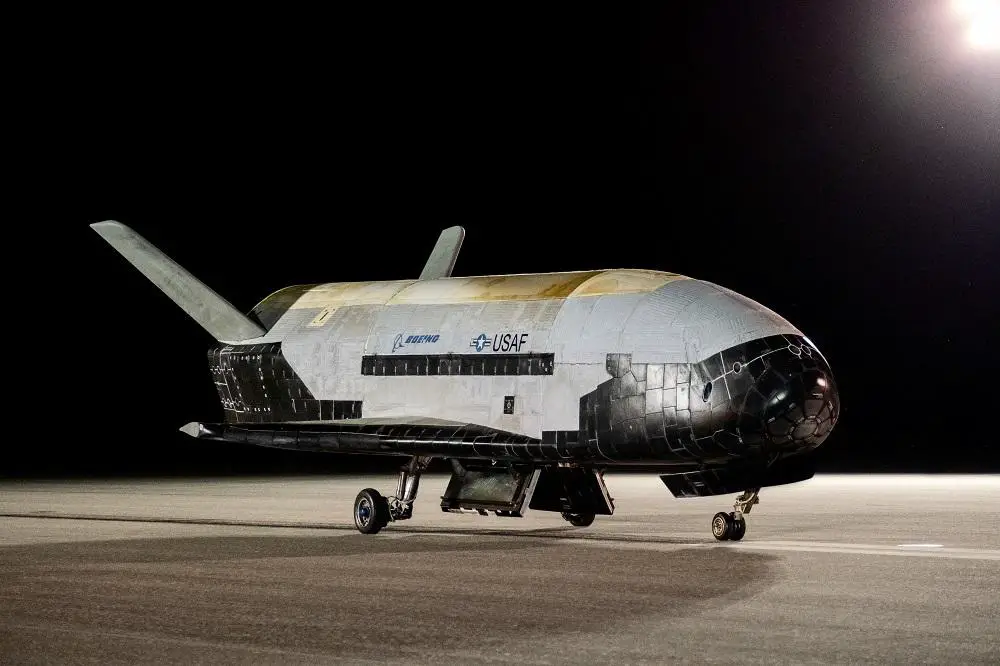The X-37B Orbital Test Vehicle-6 (OTV-6), the U.S. Space Force’s unmanned, reusable spaceplane, successfully deorbited and landed at NASA’s Kennedy Space Center Shuttle Landing Facility on Nov. 12, 2022, at 05:22 a.m. OTV-6 was the first mission to introduce a service module-a ring attached to the rear of the vehicle expanding the number of experiments that can be hosted during a mission. “This mission highlights the Space Force’s focus on collaboration in space exploration and expanding low-cost access to space for our partners, within and outside of the Department of the Air Force (DAF),” said Gen. Chance Saltzman, Chief of Space Operations.
The OTV-6 mission hosted the Naval Research Laboratory’s Photovoltaic Radiofrequency Antenna Module. This experiment successfully harnessed solar rays outside of Earth’s atmosphere and aimed to transmit power to the ground in the form of radio frequency microwave energy. Additionally, the U.S. Air Force Academy’s FalconSat-8, developed in partnership with Air Force Research Laboratory, was successfully deployed in October 2021. FalconSat-8 remains in orbit, providing Academy cadets unique hands-on experience as space operators prior to entering active duty.

The service module successfully separated from the OTV before landing, which is a necessary activity due to the aerodynamic forces experienced by the X-37B vehicle upon re-entry. In the coming weeks, the service module will be disposed of in accordance with best practices. Secretary of the Air Force Frank Kendall said, “The deliberate manner in which we conduct onorbit operations-to include the service module disposal-speaks to the United States’ commitment to safe and responsible space practices, particularly as the issue of growing orbital debris threatens to impact global space operations.”
Multiple NASA experiments were deployed on OTV-6. The Materials Exposure and Technology Innovation in Space (METIS-2) included thermal control coatings, printed electronic materials, and candidate radiation shielding materials. METIS-1-which flew on OTV-5-consisted of similar sample plates mounted on the flight vehicle. NASA scientists will leverage data collected after the materials have spent 900+ days in orbit and compare observed effects to ground simulations, validating and improving the precision of space environment models.

“The X-37B continues to push the boundaries of experimentation, enabled by an elite government and industry team behind the scenes,” said Lt. Col. Joseph Fritschen, DAF Rapid Capabilities Office’s X-37B Program Director. “The ability to conduct on-orbit experiments and bring them home safely for in-depth analysis on the ground has proven valuable for the Department of the Air Force and scientific community. The addition of the service module on OTV-6 allowed us to host more experiments than ever before.”
The Boeing X-37, also known as the Orbital Test Vehicle (OTV), is a reusable robotic spacecraft. It is boosted into space by a launch vehicle, then re-enters Earth’s atmosphere and lands as a spaceplane. The X-37 is operated by the United States Space Force for orbital spaceflight missions intended to demonstrate reusable space technologies. It is a 120-percent-scaled derivative of the earlier Boeing X-40. The X-37 began as a NASA project in 1999, before being transferred to the United States Department of Defense in 2004. Until 2019, the program was managed by Air Force Space Command.












